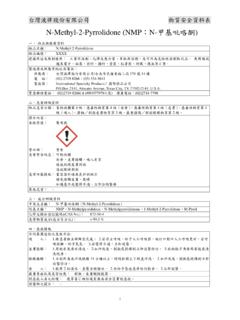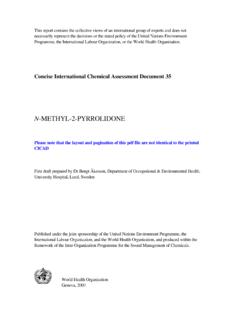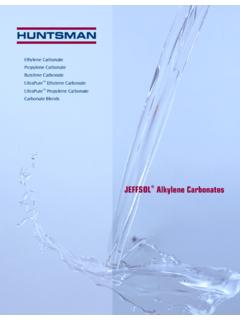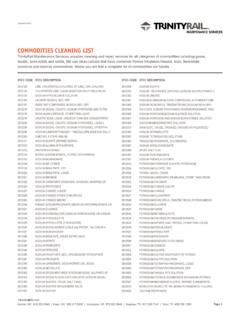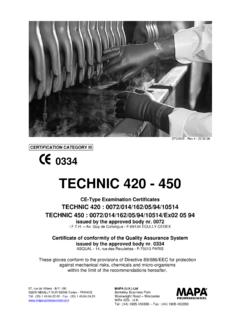Transcription of Protective glove selection for workers using NMP ...
1 Harpur Hill, Buxton Derbyshire, SK17 9JN. T: +44 (0)1298 218000. F: +44 (0)1298 218590. W: Protective glove selection for workers using NMP containing products -Graffiti removal HSL/2007/41. Project Leader: Dr. Vincent Crook (PhD). Author(s): Dr. Vincent Crook (PhD) & Mr. Andrew Simpson (BSc). Science Group: Exposure Control and Measurement Crown copyright 2007. FOREWORD. A previous study conducted by HSL in collaboration with the N- methyl pyrrolidone Producers Group Inc. presented quantitative data on potential dermal exposure to N- methyl pyrrolidone (NMP) that was gathered for the purpose of validating and improving predictive models generated by the EU RISKOFDERM project. This project was conceived as a response to the apparent risk of dermal exposure inherent in the task of graffiti removal.
2 Exposure to the hands was a particular concern.[1, 2]. ii CONTENTS. 1 INTRODUCTION: JUSTIFICATION FOR THE 1. NMP 1. Summary of previous work on graffiti workers .. 1. Specific health effects concerns relating to widespread NMP 2. NMP and gloves .. 3. Graffiti products available in the UK .. 6. Aims of This work .. 8. NMP based formulations used in this 8. 2 4-HOUR SCREENING 9. 3 SWELLING 12. Introduction to swelling 12. Experimental procedure of swelling test .. 12. Results and discussion of swelling 13. Discussion of swelling results at 8 hour point .. 19. 4 glove PERMEATION TESTS .. 23. glove and test selection .. 23. 23. 24. Observations .. 24. Discussion .. 24. 25. 5 29. 6 34. iii EXECUTIVE SUMMARY.
3 Objectives N- methyl pyrrolidone (NMP) (CAS Number 872-50-4) is a powerful solvent that is able to solvate compounds that would otherwise be immiscible and difficult to handle and process. It finds use in graffiti removal formulations. In the plastics industry, it is used as a solvent for natural and synthetic polymers. In the agricultural industry, NMP is currently in use as a co- formulant in a range of biocides including; fungicides, pesticides, herbicides and seed treatments. Often NMP is a major component of the formulation (< 70 %). NMP is also used in the large-scale recovery of hydrocarbons from industrial processes and is intrinsic in many cleaning processes in the electronics industry. In this work HSL intended to test a range of readily available chemically resistant gloves against actual graffiti removal formulations in order to inform glove selection and study the competing influences upon chemical resistance of glove type and solvent formulation.
4 The initial phase of this work involved screening for the suitability of gloves against NMP and graffiti removal formulations. gloves were selectively tested against four NMP containing formulations (GC. 300, Blitz GS, Graffiti Gone CR-GR1 and DSI 6000) and pure NMP. Sceening tests involved visual assessment of glove condition following four hours of contact with a chemical, and a 24- hour gravimetric method of assessing solvent uptake by samples of gloves . This was followed by assessment of the resistance to permeation of some of the glove types using a continuous contact test based on the BS EN 374-3. Main Findings 20 glove types were tested against NMP and relevant NMP containing formulations. This work has demonstrated that testing of gloves against NMP containing formulations rather than just pure NMP is necessary.
5 With this in mind, the authors have demonstrated the chemical durability of the North Silver Shield glove against NMP and the NMP based formulations GC. 300, DSI 6000, Blitz GS and Graffiti Gone CR-GR1 in swelling tests. Unfortunately these gloves can be awkward to work in; therefore Butyl rubber gloves may be by some workers . In swelling tests the butyl rubber type glove examined in this work (KCL Butoject 898) had good resistance to NMP, GC 300, DSI 6000 and Graffiti Gone CR-GR1 but not to Blitz GS. Blitz GS. is an appreciably more aggressive product that is designed to solvate metallic paints but has ingredients in common with most other graffiti removal products. The best performing gloves tested in continuous contact permeation tests were the North Silver Shield (T) and KCL.
6 Butoject gloves (J), which resisted continuous contact permeation for over eight hours when tested against both NMP and the commercial cleaning product Graffiti Gone CR-GR1. Of the other glove types tested, the Latex gloves demonstrated some potential chemical resistance in swelling tests against NMP but less resistance to the NMP containing formulations. It is possible that further testing could establish these gloves as splash resistant' and, if used, they should be replaced on a task-by-task basis and immediately when known to be contaminated. It was hypothesised that the 4-hour screening and 24 hours gravimetric solvent uptake tests conducted in this work may be a cost effective way of assessing gloves in less well equipped laboratories.
7 This has been demonstrated in part, however a thin polyethylene Ansell ProFood glove passed both of these tests and failed the BS EN 374-3 continuous contact permeation test. Therefore, it is only possible to say that these are useful indicator' and screening' tests that iv could preclude some glove types from further testing or could even be carried out by inspectors shortly after a visit to a site that was thought to be using unsuitable gloves with chemicals. In this work, these two screening tests eliminated 17 glove types from further investigation (although the authors tested three of these for other reasons). The 4-hour observational screening test performed in this work proved appreciably powerful.
8 In this work it eliminated 12 gloves from further investigation. It is worth noting that this test could be carried out on site simply by turning the finger of a glove inside out and pipetting some chemical into it. A handy way of visualising the permeating chemical is to use permeatec pads, these blacken when in contact with solvent, or alternatively, to put some blue roll tissue in contact with the dry' side of the glove when the chemical permeates it dampens the blue roll tissue and it turns dark blue. Of the gloves that were reported to be used by graffiti workers , the nitrile gloves were found to be unsuitable for use with pure NMP in BS EN 374-3 continuous contact permeation tests due to rapid degradation allowing a high permeation rate (32 in the case of reusable nitrile gloves and >26 in the case of a single use disposable nitrile glove type), which leaves them physically weakened.
9 An example of a thin latex type glove was also unsuitable for use with pure NMP due to very short breakthrough time (~2 mins) and a high permeation rate of > 34 Recommendations x It is recommended that North Silver Shield (layered polyethylene/ethane-vinyl alcohol). gloves (or similar) can be used to provide adequate protection when handling NMP. containing products. x Butyl gloves , used with caution, would be a second choice. In addition Butyl gloves offer advantages in dexterity and robustness. x It is recommended that gloves be tested against all relevant chemical formulations as a matter of routine in order to inform glove selection . x Assumptions of glove choice based on the use of model compounds or similar formulations should be made with extreme caution.
10 X The two screening tests used in this work proved useful indicator methods to speed up and minimise the cost of this testing gloves . x The BS EN 374-3 continuous contact test and it successors should remain the benchmark for chemically Protective glove type decisions. x It is recommended that, when necessary and feasible, gloves be tested for suitability by inspectors on site using the 4-hour observational screening test. v 1 INTRODUCTION: JUSTIFICATION FOR THE WORK. NMP USE. N- methyl pyrrolidone (NMP) (CAS Number 872-50-4) has been manufactured on a commercial scale since the 1960s.[3] Its current production in the EU is 38,000 tonnes.[4] The pH of NMP is typically between 8 and It is a colourless liquid with a mild amine odour.










